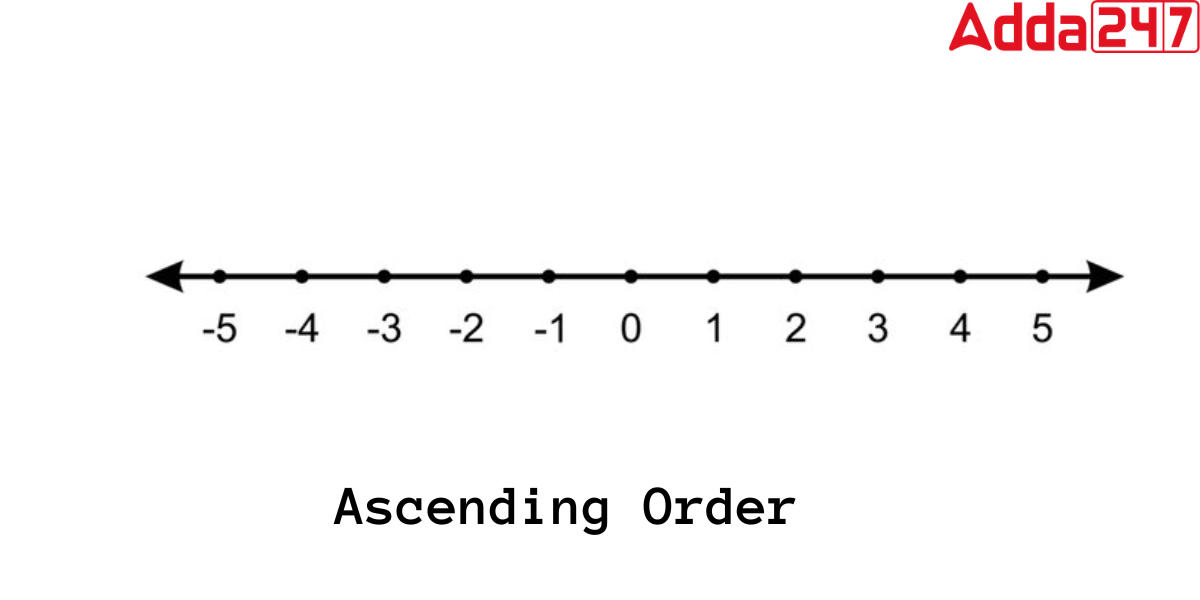Table of Contents
Ascending Order: The arrangement of components or objects in ascending order is such that each subsequent element in the arrangement is always greater than what came before it. Ascending order is also known as increasing order. For example, consider a set of integers in ascending order, such as 15< 16< 17< 18< 19< 20 < 21< 22…and so on. In this article, we are going to learn about the Ascending Order in detail.
Ascending Order Meaning
The meaning of the word Ascending signifies increasing. Ascending order in mathematics is the process of organizing numbers in increasing order, i.e., from least to highest value. The first number in ascending order is the smallest, while the last number is the largest. That is, the numbers are ordered in increasing order from left to right. A set of natural numbers can be expressed as follows in ascending order: 10<20<30<40<50 , with 10 being the smallest and 50 being the highest number.
What is Ascending Order?
Ascending order refers to the organization of data from the lowest to the highest value. Ascending Order is a method of arranging numbers in ascending order, from lowest to highest value. The order should ideally be expressed from left to right. The Less than (<) sign is used to represent ascending integers. The first number in ascending order is the smallest, while the last number is the largest. An arrangement of English alphabets from A to Z is a real-world example of ascending order.
Ascending Order Symbol
We can use the ‘less than symbol (<)” to indicate a particular collection of numbers in ascending order. This is a typical approach to express numbers in ascending order so that the number after it is greater than the number before it in the arrangement. The ascending order symbol indicates that the number on the left is less valuable than the number on the right. For instance, the numbers 5 < 4 < 3 are organized in ascending order.
Ascending Order on Number Line
Number Line is a good example to understand the concept of ascending order. The number line is a visual representation of real numbers, with each point on the line representing a different real number. Ascending Order on Number Line shows how numbers on a number line are sorted, with the rightmost number being higher than the leftmost while moving from left to right.

In the above number lines numbers from -6 to 6 are arranged in ascending order. It states that the numbers on the left side of 0 are smaller than the numbers on the right side of 0. As we go from left to right on the number line the value of numbers increases.
How to arrange numbers in Ascending Order for Class 1 & 2?
According to the definition of ascending order, it is when numbers are placed in a pattern of least to largest value, with the smallest on the left and the largest on the right. To arrange the numbers in ascending order, we must first compare the values before ordering them in ascending order. We can arrange several types of numbers in asceding order such as:
- Integers
- Negative numbers
- Fractions
- Decimals
Ascending Order of Integers
Integers are numbers that can be both positive and negative, as well as zero. When the numbers are placed in ascending order, they are easily compared. When we arrange them, we must keep in mind that all negative integers are smaller than Zero(0) and all positive numbers are bigger than Zero(0). All of the positive numbers greater than all of the negative numbers.
Ascending Order of Decimals
Decimals are integers with a whole number component and a fractional or decimal component connected by a decimal point. Check the steps discussed below to arrange the list of decimal numbers.
In the case of decimals, the whole number part of the number is compared in order to arrange them in ascending order, i.e.
We merely compare the complete number component of 8.7 and 10.8.as 8 < 10 so
8.7 < 10.8
If the whole number portion is equal, we compare the decimal portion one by one as follows:
8.785 and 10.823
In this case, 8.785 < 10.823
Ascending Order of Fraction
Ascending fraction order refers to organizing the given fractions in increasing order. There are two approaches to determining the ascending order of fractional numbers. and they are as follows:
- By converting unlike fractions into like fractions: In this method, We find the LCM (Least Common Multiple) of the denominators to convert the denominators of all the given fractions into a common denominator. The same integer is then multiplied by the numerator and denominator. After that, sort the numbers in increasing decimal value order. Replace the fractions with the actual fractions to arrange them in increasing order.
For example, Arrange 3/2, 6/5, 2/6, 2/5 in ascending order.
We find that LCM of 2, 5, and 6 is 30
3/2 × 15/15 = 45/30
6/5 × 6/6 = 36/30
2/6 × 5/5 = 10/30
2/5 × 6/6 = 12/30
As a result, the numerators of the produced fractions may now be easily compared, i.e.
10 < 12 < 36 < 45
10/30< 12/30 < 36/30 < 45/30
∴ 2/6 < 2/5 < 6/5 < 3/2
- By converting fractions to decimals: We can convert fractions to decimals by dividing the numerator by the denominator, and then we may arrange those decimals in ascending order by looking at the place values in the whole number and decimal parts. For example, to organize 1/2, 1/3, and 2/5 in ascending order, we must first convert these fractions into their decimal equivalents one by one.
1/2 = 0.5
2/5 = 0.4
1/3 = 0.34
After arranging them into increasing order we can find that,
0.34< 0.4 < 0.5
∴ 1/3 < 3/5 < 1/3.
Ascending Order of Negative Numbers
Arranging negative numbers in ascending orders is quite confusing for students at the beginning. Negative numbers in ascending order are those that are arranged from smallest to largest values. It should be remembered that the absolute values of smaller numbers are bigger than the absolute values of larger numbers in the case of negative numbers. When it comes to negative numbers, if a larger number contains a negative sign, it shrinks to be smaller than the positive number. Let’s break it down with an example.
Arrange the given numbers -45, -67, -5 in ascending order.
The given integers can be sorted as follows in ascending order:
-45 < -67 < -5
Among the given three numbers -5 is the biggest and -67 is the smallest.
Ascending Order of Alphabet
One of the best Examples of the Ascending order is the English alphabet. As with numbers, you can arrange all 26 English alphabets in ascending and decreasing order. As an example: a < b < c < d < e < f < g < h < i < j < k < l < m < n < o < p < q < r < s < t < u < v < w < x < y < z .


 UP Board Exam Date 2025 Class 12, 10 Out...
UP Board Exam Date 2025 Class 12, 10 Out...
 SOF Result 2024-25: Level 1 Date, Check ...
SOF Result 2024-25: Level 1 Date, Check ...
 NIOS Syllabus 2025 Out, Download Subject...
NIOS Syllabus 2025 Out, Download Subject...































